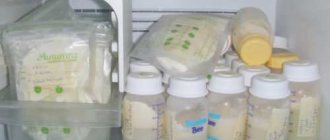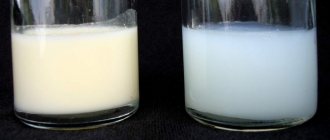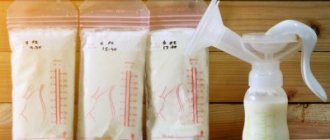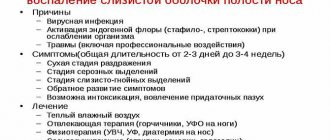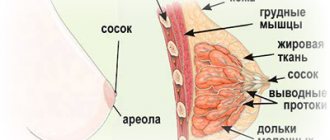The best way to feed a baby, according to all experts without exception, is breast milk. It is good if the mother spends the whole day with her baby, allowing him to feed whenever he gets hungry. But in situations where a young mother cannot be constantly with her child, if she works or is sick, feeding is carried out with pre-expressed milk. Expressed milk, which one of the relatives can feed the baby with a spoon or through a pacifier, is much preferable to using any formula milk. True, sometimes such milk needs to be prepared by heating it in the correct way.
When to reheat
It all depends on how exactly the expressed milk was stored before feeding. All the beneficial properties of mother's milk are preserved for six hours, and all this time it can simply be kept in a bottle indoors at room temperature. In this case, there is no need to warm it up; there will be no discomfort for the baby from milk at room temperature.
It’s a different matter if breast milk has to be stored longer, for example, from evening until morning, until the first feeding. In this case, it is recommended to place it in the refrigerator, where it can stand longer, several days (but no more than four). Of course, you cannot give milk directly from the refrigerator to your child; it must be warmed up before use.
In order to warm up pre-prepared expressed breast milk, there are several ways. Let's look at the most common of them.
How to Express Breast Milk
The skill of expressing breast milk is important for a nursing woman. It allows you not only to prepare a supply of food for the baby, but also to control the filling of the breast. The ability to empty the breast in the first months after childbirth is irreplaceable, since it is during the period of lactation that the risk of milk stagnation is high.
If the mammary gland is not emptied in a timely manner, the woman’s temperature will rise, inflammation will begin, and an infection may develop, which will require surgical intervention.
Manual expression is the most effective method. Lifting your breast slightly with one hand, use the index finger and thumb of your other hand to gently press on the opposite edges of the nipple areola. When performed correctly, the manipulation is completely painless, even with cracked nipples.
You can also use a breast pump. The devices are widely available in pharmacies in any price category: from the simplest with a manual bulb to electric ones. An automatic electric breast pump is the most effective. However, using any model can be painful if you have cracked nipples. It happens that there is uneven emptying of the mammary gland when using a breast pump.
If you express milk into any container and you are going to bottle-feed your baby, you must strictly adhere to the rules of hygiene:
- wash your hands with soap before pumping;
- You should not lather the mammary gland, as this removes from the surface of the nipple the normal microflora of the skin of a healthy person, which is intended to reach the baby along with breast milk; It is enough to rinse your breasts with clean water;
- all pumping accessories must not only be thoroughly washed and dried, but also sterilized after each use; to do this, you need to boil them for half an hour or use a special sterilizer;
- the younger the child, the smaller the portions of expressed milk in the storage container should be; for a baby 2 months – approximately 80 ml, 3 months – 100 ml.
Breastfed babies tend to eat smaller portions than formula-fed babies. This is due to the fact that breast milk is digested faster than formula, and the baby can be attached to the breast even more often than once every two hours.
Running water
Breast milk should be slightly warmed to prevent the baby from getting sick
This is the simplest, although not the fastest, method. It all depends on whether you simply stored the milk in the refrigerator or used the freezer.
- After taking the bottle out of the refrigerator, place it in running tap water and hold it there for a while. It is very important that the water is not hot, but slightly warm. If you immediately apply boiling water to cooled milk, it will suddenly begin to lose its beneficial properties. The main thing is that the milk in the bottle heats up evenly. After warming the bottle to room temperature, you can increase the temperature of the tap water and slightly heat the milk to a more comfortable state, up to 35 - 37 degrees.
- If the milk was stored in the freezer, it should be defrosted first, removing any ice fragments. To do this, the bottle is also placed under running water, but not warm, but cool. If you prepare milk in advance, you can simply transfer it from the freezer to a shelf in the refrigerator and let it “warm up” for a while. Having defrosted the liquid, begin to gradually increase the temperature of the running water, bringing the milk to room temperature, and then to a warm state.
Warming methods
There are many ways to properly warm breast milk, try each and choose the most comfortable option. The main rules of the process: heating should be gradual, the temperature should not exceed 36.6 degrees.
In a water bath
Grandma's most convenient method is heating in a water bath. The process is as follows: the bottle is placed in a container with cold water and placed on the fire. Do not leave for a minute; you can periodically shake the bottle to speed up uniform heating. When the water in the container reaches a warm, comfortable temperature, the milk has warmed up.
The main disadvantage is the need to stand and monitor the process.
Under running water
Usually, this method is used to heat up frozen milk that is needed urgently. With sudden heating, the structure of protein molecules changes, and the product is less digestible. Therefore, the method of gradual heating under running water is used. First, place the container under running cold water, then add hot water until the desired effect is achieved.
Cooled milk heats up much faster under running water. The water temperature should not be significantly higher than body temperature, otherwise it is easy to get burned. In this case, you need to constantly shake the container, check the temperature of the milk, and wipe away hot drops of water before giving the bottle to the child.
The disadvantage of this method is that it is so easy to overheat the milk, and you will have to wait for it to cool.
In an industrial heater
Modern industrial warmers are the most convenient way to warm breast milk. The only negative is the high cost; if used rarely, their usefulness does not pay off, as it seems at first glance. This technique will be needed to heat baby food: cereals, purees, juices.
Heaters are available in different functionality, but all have a temperature sensor to which the product is heated. The keep warm function prevents the milk from boiling. After heating, the product is stored for no more than 45 minutes.
It is very convenient that cold breast milk can be kept in the warmer all night without spoiling, and the device can be turned on only when the baby requests it.
There are no downsides to using industrial warmers; there are even models designed for frozen breast milk. Gradually increasing the processing temperature, bringing it to the required temperature.
In the microwave
There are many varied reviews regarding the use of a microwave: some raised their children on foods heated in the device and everything is fine, while others have problems with the child’s digestive system.
Milk is heated unevenly in the microwave: there are overheated areas and cold areas. It is very difficult to guess exactly how long it will take to warm a certain portion of milk. Each time the time and temperature are different. A microwave is a less suitable device for heating baby food, but the choice is everyone’s business.
The advantage is the availability of the device. The downside is its lack of knowledge and uneven heating.
Water bath
This method involves using a small saucepan half filled with water. Place the pan on the fire and wait until the water begins to boil. It is impossible to bring it to the boiling point, since the heating of the milk in this case will be too uneven.
Remove the pan from the stove - the water bath will be ready. Now put a bottle of food in it for three to four minutes. If the bottle was previously in the freezer, then you will have to heat the frozen milk for about 10 minutes.
When you remove the bottle from the water bath, shake it a little so that the temperature of the milk throughout the volume is equalized.
Suitable container
For freezing milk, specially designed bags are produced with a scale indicating the volume; they can be connected to a breast pump. But this option is not convenient for everyone. Those mothers who do not use a breast pump use plastic and glass bottles, food containers, and baby food jars for similar purposes.
However, there are certain risks in this case. It is better not to use glass containers at all for freezing milk. Such dishes may crack in the freezer. As for plastic, it should be a material that can be stored in the freezer and does not contain harmful impurities.
For example, polycarbonate is not suitable, since this plastic contains Bisphenol A. If the plastic container is marked “BPA free”, the material is completely safe. New sterile test jars are also suitable as containers.
Heater
A bottle warmer will help warm up breast milk without losing its beneficial properties.
Agree, the first two methods of heating cold milk cannot be called quick. For those parents who often have to warm up expressed milk from the refrigerator and who often resort to night feeding, it is recommended to purchase a special bottle warmer. This is also convenient if you have more than one baby on your hands, but, for example, twins - you can heat several bottles at once in the heater.
Bottle warmers come in different types. Some of them work on the same principle as a water bath, others use steam to heat them. You can prepare both types of devices in advance by filling them with hot water. Next, proceed according to the instructions.
- In a water bath heater, you simply place a bottle of cold milk directly into hot water.
- In steam heaters, a container of milk is placed in an empty compartment, into which steam begins to flow from an adjacent insulated compartment filled with hot water.
What is the advantage of this method over those described earlier? The fact is that the heaters act carefully, heating the milk evenly. A good heater can heat milk after refrigeration in two to three minutes.
Storing the product for a long time
There are times when breast milk needs to be frozen in the freezer for a long period of time. This product can be stored for 6 months or more. Then the question arises of how to properly warm breast milk from the refrigerator. First, containers with liquid are taken out of the freezer and placed in the refrigerator closer to its door. Then they give time (about eight hours) for the product to defrost on its own. After the ice has completely melted, the heating process begins. If time is limited, then the bottle of milk is gradually heated under running water.
It may seem that using frozen breast milk is very inconvenient, but it is not. Due to its long shelf life, it is always easily accessible and can come in handy in an emergency. But expressed milk can only help if the mother is absent for a short time.
It is important to remember that storing different foods in the freezer can cause frozen milk to taste off. Therefore, it is important to pack the product in sealed bottles and bags, and also to exclude proximity to other products.
Microwave
Experts do not yet have a consensus on this issue. Most parents themselves do not risk resorting to using a microwave oven to heat expressed milk, reasonably fearing for the preservation of its beneficial properties.
According to critics, microwave radiation can kill the antibodies present in milk, as well as beneficial nutritional enzymes. Also, some amino acids in breast milk, when heated strongly in the microwave, can turn into toxic isomers, and this already poses a risk to the baby’s health.
Another disadvantage is the fact that the contents of the bottle heat up in the microwave much faster than the container itself. It may seem to you that the bottle is still cool to the touch, but inside it already contains a hot composition that can burn the baby’s neck and mouth. However, most sensible parents always taste milk before giving it to their child (and rightly so), but there is still a risk.
That is, although there is no particular evidence that the nutrients and vitamins found in breast milk are necessarily destroyed under the influence of microwave radiation, it is still better not to take risks. You cannot use something whose harmlessness has not been proven - that is why, in order to be sure that the beneficial properties of milk are preserved, it is better to heat it using proven and safe methods.
However, there are no such concerns about heating cow's milk or instant formula in the microwave. Experts say that you can heat such milk or mixture in a microwave oven, you just need to follow certain precautions. First, you should find out how long it will take for the desired heating by experimenting with different bottles, modes and quantities of the mixture, starting with the lowest temperatures. And then stick to the results obtained.
How to defrost and to what temperature to heat
Breast milk is a delicate product that requires special defrosting. It should thaw gradually. The easiest way is to move the container from the freezer to the refrigerator and let it defrost completely. The process takes, on average, 12 hours (the exact time depends on the size of the portion).
Some people use a microwave for these purposes. In this case, the milk will defrost faster, but will inevitably lose some of its nutrients due to uneven heating. Pediatricians recommend refraining from this method or using it as little as possible. Moreover, when defrosting milk in a microwave oven, it can be overheated, which is best avoided.
Sometimes mothers practice defrosting under running warm water, but it is no better than the microwave option. After defrosting, the milk is heated in a water bath by placing the jar in warm water. Heating temperature – 37° C. You can use a special device used to heat bottles with the mixture. In it, the heating temperature is controlled automatically.
Before giving it to the baby, shake the bottle thoroughly to return the milk to a uniform structure. Milk cannot be re-frozen. Thawed milk can be stored for no longer than 2 hours at room temperature and no more than jokes in the refrigerator.
Of course, there is nothing better for a baby than fresh breast milk, but sometimes there is a need to stock up. This situation may arise due to the mother’s need to leave home for several days or for another reason. For example, if a parent gets sick, milk stored in the freezer will also come to the rescue.
Five rules for warming up
But no matter what method you choose to heat your baby’s food, always follow certain rules. Let's bring them.
- If you have thawed breast milk, you can no longer refreeze it in the freezer - it loses its nutritional properties.
- Any baby food that has been stored in the refrigerator can only be reheated once. If the child has not used it, the milk should be poured out and a fresh portion prepared.
- Food for children can be heated, but not boiled. You can heat it up to a maximum of 37 degrees.
- Be sure to shake the heated milk before giving it to your baby so that it becomes more homogeneous. This will avoid temperature changes.
- If you have already thawed or warmed up breast milk, try to give it to your baby within the next three to six hours. A longer shelf life of such food is no longer desirable.
Warming up feeding liquid using a heater
Very often, a young mother is concerned about the question of how to warm up breast milk from the refrigerator quickly and without wasting extra time. For these purposes, scientists have developed special heaters. Despite the fact that all devices are different, they have the same principle of operation. All of them work on the basis of steam or water bath. However, there are differences in details, so please read the instructions before use.
Some models are equipped with containers for several bottles. So, for example, in one you can heat breast milk, and in the other - a container with complementary foods.
If the heater operates using a water bath, then the bottle of milk is placed in a warm liquid. But with steam, a large amount of water is not required. In such a device there is a special compartment for liquid that is heated. Then the hot steam moves into the container with the bottle, thereby heating it.
A few tips on how to warm up breast milk from the refrigerator using a warmer:
- Water is poured into the container of the device to the desired level. If it is not there, then carefully study the instructions. It indicates the required volume of water for the heater to operate.
- Before the next use, pour out the water and add new water. This advice is relevant for both steam and water heaters.
- The bottle is carefully placed in a special container. If there is a device, then it is fixed in the required position.
- Once the temperature is set, you can heat it up. After the process is completed, a special indicator on the device will light up.
The latest models of heaters are equipped with indicators that indicate when the required amount of water runs out.
Summary
Expressed breast milk can be cooled in the refrigerator or freezer. Before use, it must be heated to the temperature of the human body, i.e. up to 35 - 37 degrees, using any of the methods described.
Defrosting or heating milk cannot be sudden, so as not to lose the beneficial characteristics of the product.
It is advisable to store milk, both freshly expressed and after defrosting, for a maximum of six hours. It can no longer be frozen again.
It is recommended to keep milk in the refrigerator for no more than four days at a temperature of +4 degrees.
Expressing breast milk
It happens that after giving birth, a young mother cannot be constantly near the baby, because of this, caring for the baby falls on the shoulders of loved ones. This problem is especially relevant for mothers who, thanks to their income, provide for the maintenance of the family.
Everyone knows perfectly well how beneficial breast milk is for a baby, especially in the first months of his life. The beneficial substances contained in it protect the baby from infections, strengthening its weak immunity.
In order not to give up breastfeeding, the mother simply needs to express the milk and store it in the refrigerator. Breast milk from the refrigerator does not lose its beneficial properties. And warming up and feeding the child will not be difficult for those caring for him. Mom can pump several times a day, if there is a lot of milk, a good place to store it is the refrigerator and freezer.
But the question immediately arises of how to warm up expressed breast milk. There is nothing complicated about this; nowadays there are many ways to perform this simple task.




